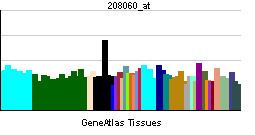Entrez 5081 | Ensembl ENSG00000009709 | |
 | ||
Aliases PAX7, HUP1, PAX7B, RMS2, Pax7, paired box 7 External IDs MGI: 97491 HomoloGene: 55665 GeneCards: PAX7 | ||
Function
Pax-7 plays a role in neural crest development and gastrulation, and it is an important factor in the expression of neural crest markers such as Slug, Sox9, Sox10 and HNK-1. PAX7 is expressed in the palatal shelf of the maxilla, Meckel's cartilage, mesencephalon, nasal cavity, nasal epithelium, nasal capsule and pons.
Pax7 is a transcription factor that plays a role in myogenesis through regulation of muscle precursor cells proliferation. It can bind to DNA as an heterodimer with PAX3. Also interacts with PAXBP1; the interaction links PAX7 to a WDR5-containing histone methyltransferase complex By similarity. Interacts with DAXX too.
Clinical significance
Pax proteins play critical roles during fetal development and cancer growth. The specific function of the paired box gene 7 is unknown but speculated to involve tumor suppression since fusion of this gene with a forkhead domain family member has been associated with alveolar rhabdomyosarcoma. Alternative splicing in this gene has produced two known products but the biological significance of the variants is unknown. Animal studies show that mutant mice have malformation of maxilla and the nose.
